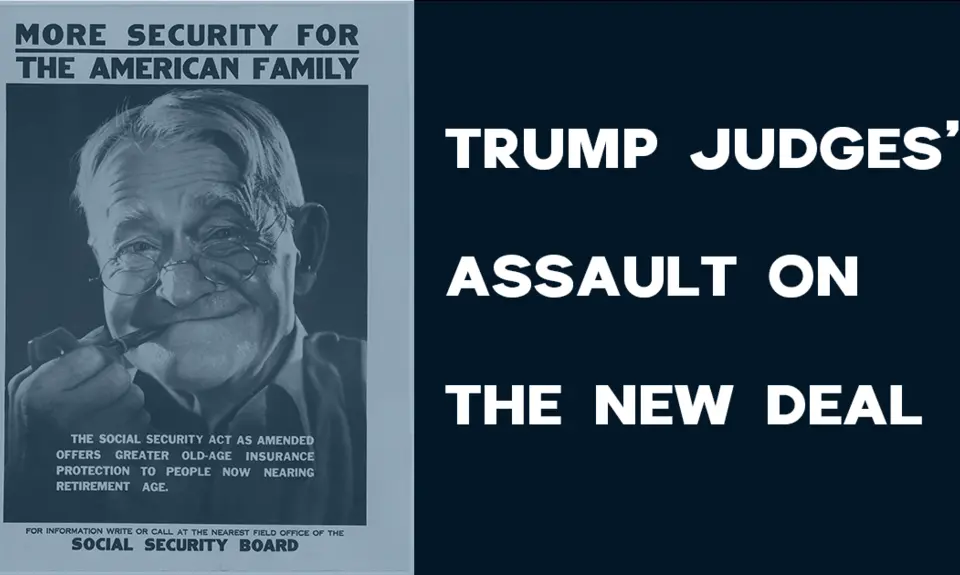For many years, an important far-right objective has been to dismantle the New Deal’s social safety net.
The New Deal, a set of programs established by President Franklin Delano Roosevelt in the 1930s, gave Americans urgently needed relief, reform and recovery from the devastating impact of the Great Depression. Key government programs under the New Deal, such as Social Security and Medicare, offered solutions to the needs of people living in poverty, seniors, and other vulnerable Americans, offered solutions to Americans’ most pressing needs.
The New Deal is also responsible for the progressive set of federal and state laws and agencies that ensure that only safe and effective drugs are put on the market; that there is a minimum wage, a 40-hour work week and the opportunity for workers to bargain with their employers; that factories do not dangerously pollute the air we breathe and the water we drink; that mitigate discrimination based on race, gender, and other characteristics; that health and safety on the job is protected, and much more.
Since he has been in office, President Trump and his administration have exploited our federal judiciary to execute the Right’s longtime dangerous goal. In 2018, former White House counsel Don McGahn, one of the architects of the Trump judicial selection process, candidly admitted the administration’s “coherent plan” to pick judges to return to the so-called Lochner era, a time when right-wing judges invalidated minimum wage and other laws as violating the “freedom of contract” and other supposed “rights” of businesses and the wealthy, to dismantle what the far Right calls the “administrative state” and effectively repeal the New Deal.
Indeed, many of Trump’s judicial picks have records of strong opposition to progressive action by government. PFAW has been tracking these efforts in our Confirmed Judges, Confirmed Fears blog series to expose the Trump administration’s effort to take away, by judicial fiat, Americans’ established rights, liberties, and health and safety protections codified under laws going back to the New Deal, and to use pre-New Deal legal theories to impede today’s Congress and legislatures from enacting new protections.
Below are four recent examples of Trump judges’ votes that demonstrate Trump-appointed judges’ complicity in the dangerous attack on the New Deal and its social safety net programs.
- During the 2017 – 2018 Supreme Court term, Trump justice Neil Gorsuch wrote a 5-4 decision in Epic Systems Corp. v. Lewis that allows corporations to force its employees to individually arbitrate claims that the business underpaid them in violation of minimum wage laws and to give up the right of workers to band together and sue or arbitrate such claims. As Justice Stephen Breyer pointed out at oral argument, allowing that practice by corporations undermines “the entire heart of the New Deal.”
- On the appellate court level, in Association of Equipment Manufacturers v. Burgum, Trump Eighth Circuit judge David Stras cast the deciding vote to enjoin a North Dakota law that tried to protect dealers and the farming community from improper practices by big equipment manufacturing companies, in an opinion claiming that the law violated the companies’ “right to contract” under the Constitution’s contract clause. The conservative Bush judge who dissented noted that the modern Supreme Court has “very rarely” invalidated legislation under the contract clause, and the decision is clearly an effort to “revive long-discarded notions” of the “right to contract” under Lochner v. New York.
- In addition to decisions that weaken New Deal practices and legal previsions, Trump judges are also issuing decisions that limit Congress’ authority and exalt the power of the president, as the Federalist Society and others have advocated as part of their pre-New Deal view. For example, in Trump v. Mazars USA, the D.C. Circuit majority upheld a House committee subpoena for President Trump’s financial records as part of the committee’s legislative oversight authority. Dissents from Trump judges Neomi Rao and Greg Katsas tried to quash the subpoena in Mazars, with Katsas arguing that upholding the subpoena is “a “threat to presidential autonomy and independence.”
- Similarly, in the ultra-conservative Fifth Circuit, the majority decision in Collins v. Mnuchin, joined by Trump judges Don Willett, James Ho, Kyle Duncan, Kurt Engelhardt, and Andrew Oldham, played a crucial role in ruling that Congress did not have the authority to create the Federal Housing Finance Agency and insulate its director from firing by the president except for cause.
We fully expect Trump judges and Supreme Court justices will continue to issue similar decisions and opinions that try to limit the government’s ability to enact important protections for consumers, workers, and other Americans. And there are already two possible Supreme Court cases on the horizon: the Court agreed in October to hear a case on the constitutionality of Congress’ creation of the Consumer Financial Protection Bureau without giving the president the power to replace its director for any reason he chooses. (Now-Justice Brett Kavanaugh has made his views on presidential power clear as a judge on the D.C. Circuit when he, argued in a dissent that such a protection for agency independence is unconstitutional under pre-New Deal legal theories.) And the Fifth Circuit is now considering another challenge to the Affordable Care Act that could “take away health care from millions of Americans.”
As long as Trump is president – and as long as Senate Republicans continue to rubber-stamp his judicial picks –we will see more and more of such efforts by Trump judges to repeal the New Deal and limit Congress’ authority. That’s why it’s critically urgent to keep track of Trump’s dangerous judicial nominees and their harmful efforts to gut the New Deal, which you can do using our newly released Confirmed Judges, Confirmed Fears tool.
And in 2020, we all must hold every senator – and the president – accountable for the damage they have committed to our federal judiciary.
